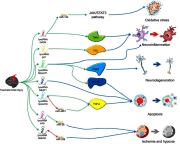The role of long noncoding RNA in traumatic brain injury
- PMID: 31303755
- PMCID: PMC6605043
- DOI: 10.2147/NDT.S206624
The role of long noncoding RNA in traumatic brain injury
Abstract
Traumatic brain injury (TBI), a mainly lethal and highly debilitating condition, is increasing worldwide. However, the underlying mechanism has not been fully elucidated and effective therapy is needed. Long noncoding RNAs (lncRNAs), which form a major class of noncoding RNAs, have emerged as novel targets for regulating physiological functions and mediating numerous neurological diseases. Notably, gene expression profile analyses have demonstrated aberrant changes in lncRNA expression in the cerebral cortex and hippocampus of rats, mice and human after TBI. lncRNAs may be associated with multiple pathophysiological processes following TBI and might play a crucial role in complications of TBI, such as traumatic optic neuropathy due to the regulation of specific signaling pathways. Some lncRNAs have also been found to be therapeutic targets for motor and cognitive recovery after TBI. lncRNAs may be promising biomarkers for TBI diagnosis, treatment, and prognosis prediction. However, further research isneeded to clarify the underlying mechanisms and therapeutic effects of lncRNAs on TBI. We review the current progress of studies on lncRNAs in TBI to draw more attention to their roles in this debilitating condition.
Keywords: long non-coding RNA; neuropathy; traumatic brain injury.
Conflict of interest statement
The authors report no conflicts of interest in this work.
Figures


Similar articles
-
The Emerging Role of lncRNAs in Spinal Cord Injury.Biomed Res Int. 2019 Oct 15;2019:3467121. doi: 10.1155/2019/3467121. eCollection 2019. Biomed Res Int. 2019. PMID: 31737660 Free PMC article. Review.
-
Research Progress on the Inflammatory Effects of Long Non-coding RNA in Traumatic Brain Injury.Front Mol Neurosci. 2022 Mar 10;15:835012. doi: 10.3389/fnmol.2022.835012. eCollection 2022. Front Mol Neurosci. 2022. PMID: 35359568 Free PMC article. Review.
-
Alteration in Long Non-Coding RNA Expression after Traumatic Brain Injury in Rats.J Neurotrauma. 2017 Jul 1;34(13):2100-2108. doi: 10.1089/neu.2016.4642. Epub 2017 Mar 21. J Neurotrauma. 2017. PMID: 28145813
-
Microarray Expression Profile of lncRNAs and mRNAs in Rats with Traumatic Brain Injury after A2B5+ Cell Transplantation.Cell Transplant. 2017 Oct;26(10):1622-1635. doi: 10.1177/0963689717723014. Cell Transplant. 2017. PMID: 29251113 Free PMC article.
-
The Involvement of Long Non-coding RNA and Messenger RNA Based Molecular Networks and Pathways in the Subacute Phase of Traumatic Brain Injury in Adult Mice.Front Neuroinform. 2022 Mar 4;16:794342. doi: 10.3389/fninf.2022.794342. eCollection 2022. Front Neuroinform. 2022. PMID: 35311004 Free PMC article.
Cited by
-
Discoveries for Long Non-Coding RNA Dynamics in Traumatic Brain Injury.Biology (Basel). 2020 Dec 10;9(12):458. doi: 10.3390/biology9120458. Biology (Basel). 2020. PMID: 33321920 Free PMC article. Review.
-
Effect of exosome-derived non-coding RNA on traumatic brain injury.Zhong Nan Da Xue Xue Bao Yi Xue Ban. 2021 Feb 28;46(2):183-188. doi: 10.11817/j.issn.1672-7347.2021.190702. Zhong Nan Da Xue Xue Bao Yi Xue Ban. 2021. PMID: 33678656 Free PMC article. Chinese, English.
-
Expression Profiles of Long Non-coding RNA and Messenger RNA in Human Traumatic Brain Injury.Mol Ther Nucleic Acids. 2020 Aug 19;22:99-113. doi: 10.1016/j.omtn.2020.08.012. Online ahead of print. Mol Ther Nucleic Acids. 2020. PMID: 32919233 Free PMC article.
-
Identification of the biological function of miR-9 in spinal cord ischemia-reperfusion injury in rats.PeerJ. 2021 May 13;9:e11440. doi: 10.7717/peerj.11440. eCollection 2021. PeerJ. 2021. PMID: 34035993 Free PMC article.
-
Construction of a lncRNA-associated competing endogenous RNA regulatory network after traumatic brain injury in mouse.Mol Brain. 2022 May 2;15(1):40. doi: 10.1186/s13041-022-00925-8. Mol Brain. 2022. PMID: 35501920 Free PMC article.
References
-
- Air M, Menon DK, Adelson PD, et al. Traumatic brain injury: integrated approaches to improve prevention, clinical care, and research. Lancet Neurol. 2017;16:987–7048. - PubMed
Publication types
LinkOut - more resources
Full Text Sources

